The Rise in Neodymium Magnet, Lanthanum and Cerium-based Application Demand Contributes to Noteworthy Market Growth
The seventeen rare-earth elements are cerium (Ce), dysprosium (Dy), erbium (Er), europium (Eu), gadolinium (Gd), holmium (Ho), lanthanum (La), lutetium (Lu), neodymium (Nd), praseodymium (Pr), promethium (Pm), samarium (Sm), scandium (Sc), terbium (Tb), thulium (Tm), ytterbium (Yb), and yttrium (Y). They find important applications in various industries, such as catalysts, magnets, glass, polishing, batteries, metallurgy and phosphors and pigments.
The key product types pertaining to every application area have been considered during the course of this research study conducted at a global level. Applications of rare earth elements have been quantitatively explained for all key regions and further broken down into key sub-regions.
The global rare earth materials market is expected to witness moderate growth in volume shipment over the forecast period. The increasing demand for rare earth products to meet high-end applications across various industries is expected to drive the market growth of rare earth materials. Asia-Pacific is is the leader not only in terms of identified rare earth deposits but also production, processing, and supply of rare earth materials at the global level. China, Australia, and Malaysia are the key countries involved in rare earth mining and processing activities.
Infrastructure development, demand rise for electric vehicles and for NdPr-based permanent magnets across the globe have been fuelling the demand for rare earth materials considerably. The demand is also indicating a preference for high-purity, customized products that yield high application efficiency.
Rare earth mining and processing companies outside of China have been strategizing to self-finance fresh exploration projects and to simultaneously develop comprehensive rare earth ore processing and supply chain competencies independent of Chinese investments and infrastructure. The objective has been to mitigate the dependency on China for the supply of rare earth products.
As the rare earth materials market is heavily influenced by Chinese supplies which cause supply and price uncertainties, end-users outside of China have been seeking rare-earth alternatives. Substitutes (e.g., cobalt) are being researched for permanent magnet applications in the field of microelectronics.
Over the last decade, massive infrastructural development activities have taken place in developing economies, such as China, India, Brazil, and Southeast Asia.
Electric and hybrid motor vehicle development and wind turbine manufacturing growth have been contributing to the rise in demand for rare earth materials used in the relevant manufacturing processes. The rise in permanent magnet, catalyst and metallurgical industry applications is expected to contribute to substantial market growth. Environmental regulations in developed countries have been pressing the need for environment-friendly vehicles which call for the use of rare earth materials as a raw material. In specific cases, the annual growth of prices has been very high; for instance, neodymium prices have risen substantially in 2018 (over 2017 prices) due to a strong demand rise for magnet applications for which there is significant demand.
Key Issues Addressed:
- What are the product and end-use application trends in the rare earth materials market space?
- What are the major challenges that participants in the rare earth materials market face?
- What are the key factors that drive or restrict growth in this market?
- What are the major rare earth element product types?
- Who are the key market participants in the rare earth materials market space?
- What are the regional trends in the market?








